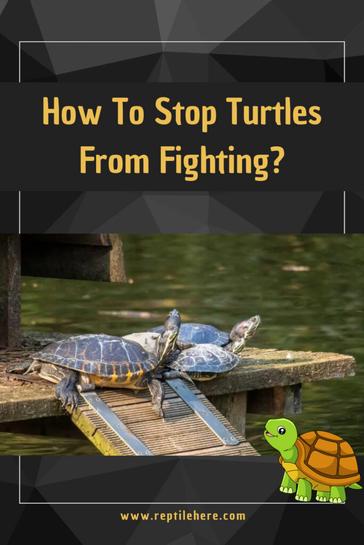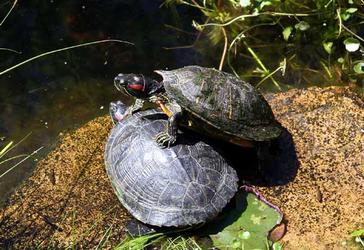Have you ever wondered why baby turtles can sometimes display aggressive behaviors? It may seem surprising, but aggression is a natural instinct in many animal species, including turtles. In this article, we will explore the reasons behind aggression in baby turtles and how to effectively manage it.
Baby turtles, like any other young animals, are learning to navigate their environment and establish their place in the social hierarchy. Aggression often arises from competition for resources such as food and territory. It is their way of asserting dominance and ensuring their survival. Understanding this natural behavior is crucial in effectively managing aggression in baby turtles.
There are several strategies you can employ to help manage aggression in baby turtles. One important step is to provide ample resources, such as food and hiding spots, to minimize competition. Creating a suitable habitat with enough space for each turtle can also reduce the likelihood of aggressive encounters. Additionally, observing and separating turtles that consistently display aggressive behavior can help maintain a harmonious environment for all the turtles.
In the following article, we will delve deeper into the specific causes of aggression in baby turtles and provide more detailed strategies for managing it. By understanding the natural instincts of baby turtles and implementing appropriate measures, you can create a peaceful and thriving environment for your little reptilian friends. So, keep reading to learn more about understanding and managing aggression in baby turtles.
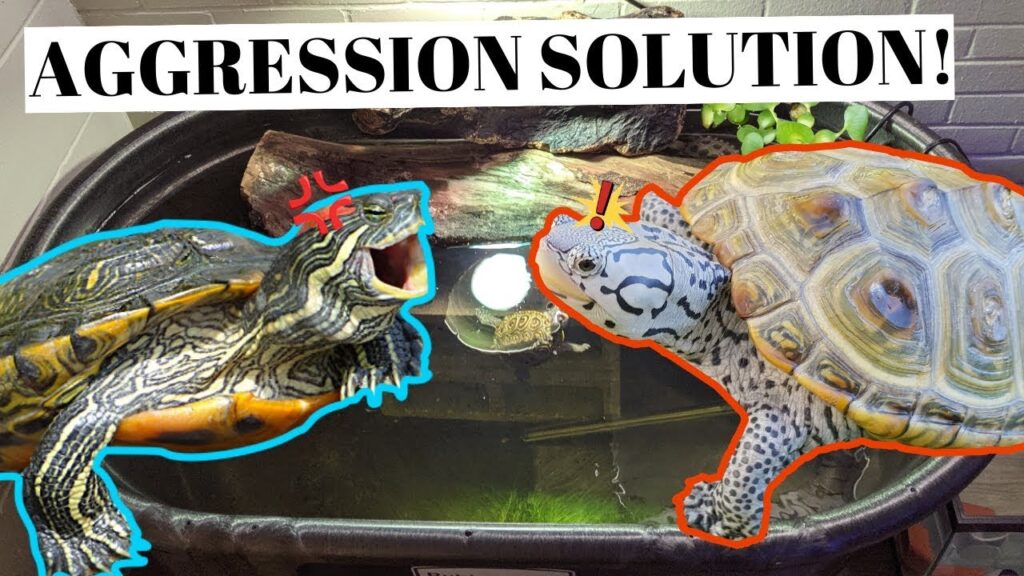
Aggression in Baby Turtles
Baby turtles are known for their adorable and innocent appearance, but aggression is not uncommon in these seemingly harmless creatures. Understanding the causes and types of aggressive behavior in baby turtles is vital for their well-being and the overall harmony of their community. In this article, we will explore the various factors that contribute to aggression, the different types of aggressive behavior, and the impact it can have on these fragile creatures. Additionally, we will provide insights into how to recognize signs of aggression, the environmental factors that influence it, and ways to manage and prevent aggression in baby turtles.
Causes of Aggression
Aggression in baby turtles can stem from several factors. It is essential to identify these causes to address and manage the aggressive behavior effectively. Territorial instincts, competition for food and resources, and mating behavior all play significant roles in triggering aggression.
Territorial instincts are deeply ingrained in many animal species, and baby turtles are no exception. Each turtle may have a defined territory and become aggressive when another turtle tries to invade it. This territorial aggression is often displayed through aggressive body language, such as hissing, baring of teeth, or widening of the eyes.
Competition for limited food and resources is another leading cause of aggression among baby turtles. In an environment with limited food sources or shelter, turtles may become aggressive in their attempts to secure these essential resources. This type of aggression is most commonly observed during feeding times, where competition can be intense.
Mating behavior also contributes to aggression in baby turtles, especially in males. During the mating season, these turtles may become highly territorial and engage in aggressive displays to defend their potential mates. Biting, snapping, and chasing are common aggressive behaviors exhibited by male turtles during this time.
Types of Aggressive Behavior
Understanding the different types of aggressive behavior displayed by baby turtles can help us recognize and address the issue effectively. Biting and snapping, shell ramming, and chasing and lunging are some of the common aggressive behaviors observed in these tiny reptiles.
Biting and snapping are aggressive behaviors where turtles use their sharp beaks to latch onto their opponents. This behavior can result in injuries or wounds and is often a sign of territorial or mating aggression. Shell ramming, on the other hand, involves forcefully colliding shells with another turtle, usually during a territorial dispute. This behavior can cause significant damage to the turtles involved and may even lead to serious injuries.
Chasing and lunging are more passive aggressive behaviors that are often seen during feeding times or when a turtle feels threatened. The chasing behavior involves actively pursuing another turtle and trying to intimidate or establish dominance. Lunging, on the other hand, is a sudden and forceful extension of the neck to strike at the opponent.
The Impact of Aggression on Baby Turtles
Aggression in baby turtles can have several detrimental effects on their overall well-being. Understanding the consequences of aggressive behavior is crucial for ensuring the health and development of these delicate reptiles.
One major impact of aggression is the potential for injuries and wounds. Biting, snapping, and shell ramming can cause severe physical harm, leading to bleeding, infections, or even the loss of limbs. These injuries can be life-threatening for baby turtles and may require immediate veterinary attention.
Aside from physical injuries, aggression also causes significant stress to baby turtles. Continuous exposure to aggression can lead to chronic stress, which can affect their immune system and overall health. Stress can weaken their ability to fight off infections and diseases, making them more susceptible to illnesses.
Furthermore, aggression can hinder the growth and development of baby turtles. Constant aggression leads to a constant state of alertness and can limit their ability to feed properly or explore their surroundings. This can result in stunted growth or delayed development, impacting their long-term health.

Recognizing Signs of Aggression
Being able to recognize the signs of aggression in baby turtles is crucial for intervening and managing their behavior effectively. While it may vary depending on the species, there are some common indicators to look out for.
Aggressive body language is the most obvious sign of aggression. Hissing, hissing, aggressive posturing, and widening of the eyes are all visual cues that indicate aggression. These behaviors are often accompanied by audible cues such as hissing or growling.
Dominance displays are also common signs of aggression. Turtles may raise their heads high, puff out their chests, or extend their limbs in an attempt to assert dominance over a rival. These displays are typically seen during territorial disputes.
Environmental Factors Influencing Aggression
The environment in which baby turtles are kept plays a critical role in their behavior and level of aggression. Certain factors can exacerbate or alleviate aggression among individual turtles.
Insufficient space is a significant contributing factor to aggressive behavior. In overcrowded tanks or enclosures, turtles may be forced to compete intensely for limited resources. Increasing the size of their habitat and providing ample space for each turtle can help reduce aggression.
Inadequate hiding spots can also contribute to aggression. Baby turtles need places to retreat and create their territories. Without enough hiding spots, they may feel vulnerable and resort to aggression as a defense mechanism. Providing an adequate number of hiding spots can help alleviate aggression and allow turtles to establish their territories peacefully.
Maintaining proper water quality is essential to prevent aggression in baby turtles. Poor water conditions, such as high ammonia or nitrate levels, can cause stress and discomfort. This can lead to increased aggression among turtles. Regular water changes and maintaining appropriate filtration systems are crucial for maintaining optimal water quality.
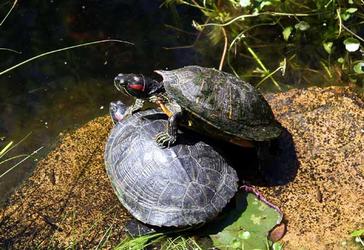
Managing Aggression in Baby Turtles
Managing and preventing aggression in baby turtles is essential for their well-being and the overall harmony of their community. Several strategies can be employed to address aggression effectively.
If aggressive behavior is observed, separating the aggressive turtle from others may be necessary. This can be done by temporarily housing them in individual tanks until their behavior improves. This isolation period allows the turtle to calm down and reduces the potential for further aggression.
Providing appropriate tank conditions is also crucial in managing aggression. Ensuring there is enough space for each turtle, sufficient hiding spots, and proper water quality can significantly reduce aggressive behavior. A well-designed habitat with basking areas and water temperature within the species’ optimal range can promote a healthier and less aggressive environment.
Feeding strategies can also play a role in minimizing aggression among baby turtles. Ensuring each turtle has access to an adequate food supply can help alleviate competition and reduce aggressive behavior. Feeding turtles separately or at different areas within the tank can help prevent conflict during feeding times.
Creating a Suitable Habitat
Creating a suitable habitat is essential for the well-being of baby turtles and can help minimize aggression. An ideal tank setup for baby turtles should prioritize their natural behaviors and provide a comfortable environment where aggression is less likely to occur.
Providing sufficient space for each turtle is crucial in preventing territorial disputes and aggression. As a general rule, each turtle should have at least ten gallons of water per inch of shell length. This allows them to establish their territories and reduces competition for limited resources.
Adequate hiding spots and basking areas are also important in creating a harmonious habitat. Hiding spots allow turtles to retreat and feel secure, reducing their susceptibility to aggression. Basking areas that mimic their natural environment, including UVB lighting and heat lamps, provide essential heat and light for their overall well-being.
Maintaining optimal water quality and temperature is vital for the health and behavior of baby turtles. Clean, well-filtered water with appropriate temperature levels promotes their overall well-being, reduces stress, and minimizes aggressive behavior. Regular water changes and water parameter monitoring are necessary to ensure a suitable environment for baby turtles.
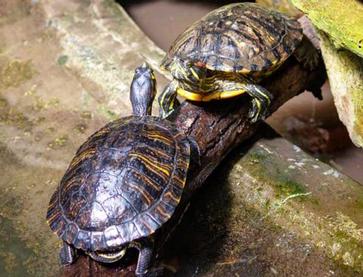
Training and Socialization
Training and socialization can play a significant role in managing aggression among baby turtles. Positive reinforcement techniques can be employed to encourage desirable behaviors and discourage aggressive behavior. Rewarding calm and non-aggressive behavior can help shape their behavior over time.
Introducing turtles to one another gradually and under controlled circumstances can facilitate socialization and reduce aggression. This process allows the turtles to establish a hierarchy and learn to coexist peacefully. However, it is essential to monitor their interactions closely to ensure that aggression is not escalating.
Assessing the Need for Intervention
Assessing the severity and frequency of aggression is crucial in determining the need for intervention. If aggressive behavior becomes frequent or escalates to a severe level, it may be necessary to seek professional advice. Consulting with a reptile veterinarian or experienced reptile expert can provide valuable insights and guidance in managing aggression among baby turtles.
In conclusion, understanding and managing aggression in baby turtles is crucial for their well-being and the peaceful coexistence of their community. By recognizing the causes, types, and impact of aggression, we can implement effective strategies to prevent and address aggression in these fragile creatures. Proper tank conditions, suitable habitat design, training, and socialization all play significant roles in promoting a healthy and peaceful turtle community. With the right care and attention, baby turtles can thrive in a harmonious environment, free from the detrimental effects of aggression.
